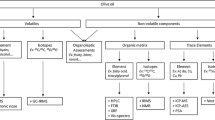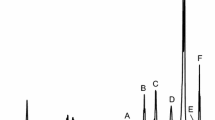Abstract
In this study, trace element contents and stable carbon isotope ratios of olive oils were determined to evaluate their potential as authentication parameters. Forty-nine virgin olive oil samples (VOOs) from six different locations of the western part of Turkey (İzmir, Manisa, Aydın, Muğla, Bursa and Edremit Bay) were analysed with ICP-MS and EA-IRMS. V, Mn, Ni, Cu, Ba, Na, K, Ca, Fe, Mg, Pb, As, Co, Cr and Zn were found in the olive oil samples and determined δ13C stable istope ratios. Data from the olive oil samples were compiled and classified with chemometric approach. The results showed that there is significant potential to successfully authenticate olive oils according to Fe and Zn on the Manisa and δ13C have dominant effect on the location of Edremit Bay. As a result, the outcome of this study could be used to identify the geographical origin of olive oils especially for the Manisa and Edremit Bay locations.






Similar content being viewed by others
References
Aparicio R, Luna G (2002) Characterisation of monovarietal virgin olive oils. Eur J Lipid Sci Technol 104:614–627
Drivelos SA, Georgiou CA (2012) Multi-element and multi-isotope-ratio analysis to determine the geographical origin of foods in the European Union. TrAC Trends Anal Chem 40:38–51
Gonzálvez A, Armenta S, de la Guardia M (2010) Adulteration detection of argan oil by inductively coupled plasma optical emission spectrometry. Food Chem 121(3):878–886
Kelly S, Heaton K, Hoogewerff J (2005) Tracing the geographical origin of food: the application of multi-element and multi-isotope analysis. Trends Food Sci Technol 16(12):555–567
Beltrán M, Sánchez-Astudillo M, Aparicio R, García-González DL (2015) Geographical traceability of virgin olive oils from south-western Spain by their multi-elemental composition. Food Chem 169:350–357
Camin F, Larcher R, Perini M, Bontempo L et al (2010) Characterisation of authentic Italian extra-virgin olive oils by stable isotope ratios of C, O and H and mineral composition. Food Chem 118(4):901–909
Vandecandelaere E (2010) Geographic origin and identification labels: associating food quality with location. In: Innovation in food labelling edited by Janice Albert. Published by the Food and Agriculture organization of the United Nations and Woodhead Publishing Limited.
Luykx DMAM, van Ruth SM (2008) An overview of analytical methods for determining the geographical origin of food products. Food Chem 107:897–911
Ulberth F, Buchgraber M (2000) Authenticity of fats and oils. Eur J Lipid Sci Technol 102(11):687–694
Karabagias I, Michos C, Badeka A, Kontakos S et al (2013) Classification of Western Greek virgin olive oils according to geographical origin based on chromatographic, spectroscopic, conventional and chemometric analyses. Food Res Int 54(2):1950–1958
Portarena S, Gavrichkova O, Lauteri M, Brugnoli E (2014) Authentication and traceability of Italian extra-virgin olive oils by means of stable isotopes techniques. Food Chem 164:12–16
Camin F, Pavone A, Bontempo L, Wehrens R et al. (2016) The use of IRMS, 1 H-NMR and chemical analysis to characterise Italian and imported Tunisian olive oils. Food Chem 196:98–105
Alonso-Salces RM, Héberger K, Holland MV, Moreno-Rojas JM et al (2010) Multivariate analysis of NMR fingerprint of the unsaponifiable fraction of virgin olive oils for authentication purposes. Food Chem 118(4):956–965
Benincasa C, Lewis J, Perri E, Sindona G et al (2007) Determination of trace element in Italian virgin olive oils and their characterization according to geographical origin by statistical analysis. Anal Chim Acta 585(2):366–370
Llorent-Martínez EJ, Ortega-Barrales P, Fernández-De Córdova ML et al (2011) Investigation by ICP-MS of trace element levels in vegetable edible oils produced in Spain. Food Chem 127(3):1257–1262
Zhao Y, Zhang B, Chen G, Chen A et al (2014) Recent developments in application of stable isotope analysis on agro-product authenticity and traceability. Food Chem 145:300–305
Banerjee S, Kurtis Kyser T, Vuletich A, Leduc E (2015) Elemental and stable isotopic study of sweeteners and edible oils: Constraints on food authentication. J Food Compos Anal 42:98–116
Portarena S, Farinelli D, Lauteri M, Famiani F et al (2015) Stable isotope and fatty acid compositions of monovarietal olive oils: implications of ripening stage and climate effects as determinants in traceability studies. Food Control 57:129–135
Angerosa F, Camera L, Cumitini S, Gleixner G et al, (1997) Carbon stable isotopes and olive oil adulteration with pomace oil. J Agric Food Chem 45(8):3044–3048
Spangenberg JE, Macko SA, Hunziker J (1998) Characterization of olive oil by carbon isotope analysis of individual fatty acids: implications for authentication. J Agr Food Chem 46(10):4179–4184
Spangenberg JE, Ogrinc N (2001) Authentication of vegetable oils by bulk and molecular carbon isotope analyses with emphasis on olive oil and pumpkin seed oil. J Agric Food Chem 49:1534–1540
Bréas O, Guillou C, Reniero F, Sada E et al (1998) Oxygen-18 measurement by continuous flow pyrolysis/isotope ratio mass spectrometry of vegetable oils. Rapid Commun Mass Spectrom 12:188–192
Angerosa F, Bréas O, Contento S, Guillou C et al (1999) Application of stable isotope ratio analysis to the characterization of the geographical origin of olive oils. J Agric Food Chem 47(3):1013–1017
Chiavaro E, Cerretani L, di Matteo A, Barnaba C et al (2011) Application of a multidisciplinary approach for the evaluation of traceability of extra virgin olive oil. Eur J Lipid Sci Technol 113:1509–1519
Diomande D, Antheaume I, Leroux M, Lalande J et al (2015) Multi-element, multi-compound isotope profiling as a means to distinguish the geographical and varietal origin of fermented cocoa (Theobroma cacao L.) beans. Food Chem 188:576–582
Longobardi F, Casiello G, Sacco D, Tedone L et al, (2011) Characterisation of the geographical origin of Italian potatoes, based on stable isotope and volatile compound analyses. Food Chem 124(4):1708–1713
Oliveira AC, Dos Santos VS, Dos Santos DC, Carvalho RDS et al (2014) Determination of the mineral composition of Caigua (Cyclanthera pedata) and evaluation using multivariate analysis. Food Chem 152:619–623
IOC, International Olive Council. http://www.internationaloliveoil.org/. Accessed: 28.05.2016
TUIK, Turkish Statistical Institute. http://www.tuik.gov.tr/. Accessed: 29.05.2016
Şahan Y, Basoglu F, Gücer S (2007) ICP-MS analysis of a series of metals (Namely: Mg, Cr, Co, Ni, Fe, Cu, Zn, Sn, Cd and Pb) in black and green olive samples from Bursa, Turkey. Food Chem 105(1):395–399
TGDMRE, Turkish General Directorate of Mineral Research and Exploration. http://www.mta.gov.tr/v2.0/turkiye_maden/maden_potansiyel_2010/manisa_madenler.pdf/. Accessed: 29.05.2016
TMEU, Republic of Turkey Ministry of Environment and Urbanisation. http://www.csb.gov.tr/db/ced/editordosya/manisa_icdr2011.pdf/ Accessed: 29.05.2016
Zeiner M, Steffan I, Cindric IJ (2005) Determination of trace elements in olive oil by ICP-AES and ETA-AAS: A pilot study on the geographical characterization. Microchem J 81(2):171–176
Acknowledgements
This work was supported by the EGE University Drug Research and Pharmacokinetic Development and Applied Center (ARGEFAR). The authors thank all ARGEFAR’s Environmental and Food (ÇEG) laboratories personnel for their help.
Author information
Authors and Affiliations
Corresponding author
Ethics declarations
Conflict of interest
The authors declare that they have no conflicts of interest.
Compliance with ethics requirements
This article does not contain any studies with human or animal subjects.
Electronic supplementary material
Below is the link to the electronic supplementary material.
Rights and permissions
About this article
Cite this article
Gumus, Z.P., Celenk, V.U., Tekin, S. et al. Determination of trace elements and stable carbon isotope ratios in virgin olive oils from Western Turkey to authenticate geographical origin with a chemometric approach. Eur Food Res Technol 243, 1719–1727 (2017). https://doi.org/10.1007/s00217-017-2876-4
Received:
Accepted:
Published:
Issue Date:
DOI: https://doi.org/10.1007/s00217-017-2876-4




